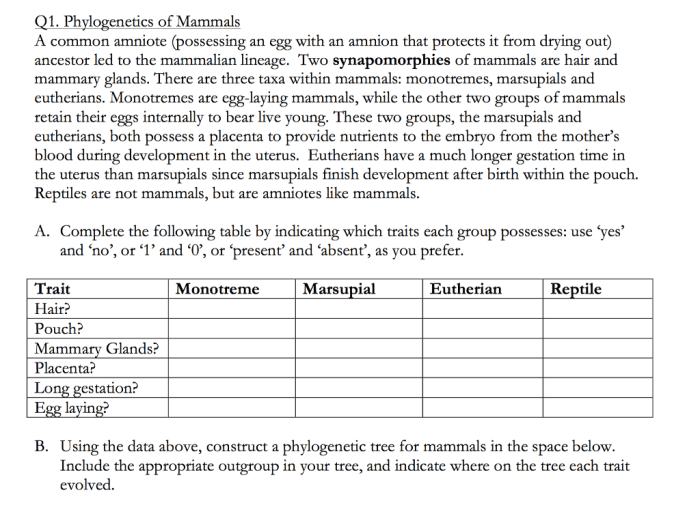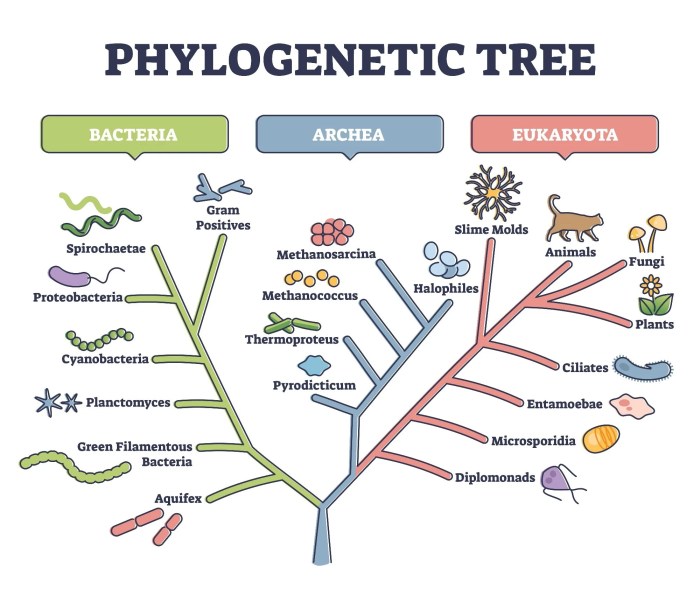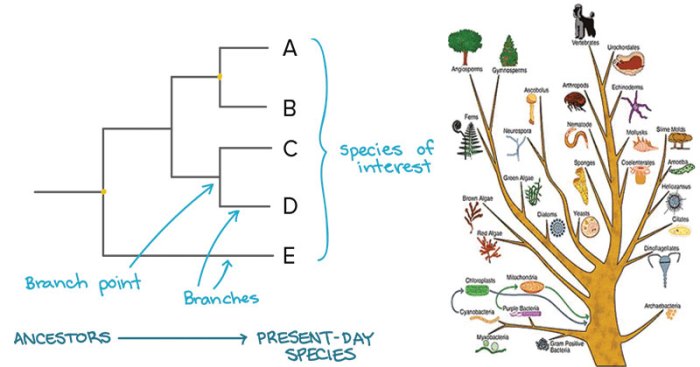Ap biology lab/cladograms and phylogenetic trees answers key – The AP Biology Lab: Cladograms and Phylogenetic Trees Answers Key is a comprehensive resource for students studying the principles of cladistics and phylogenetic tree construction. This guide provides clear and concise explanations of the key concepts involved in cladistics, including the identification of shared derived characters and the construction of cladograms.
Additionally, the guide includes a variety of examples and exercises to help students practice their skills in constructing and interpreting phylogenetic trees.
This guide is an essential resource for any student taking an AP Biology course. It provides a clear and concise overview of the principles of cladistics and phylogenetic tree construction, and it includes a variety of examples and exercises to help students practice their skills.
With this guide, students will be well-prepared to succeed on the AP Biology exam.
Cladistics and Phylogenetic Trees

Cladistics is a method of classifying organisms based on their shared derived characters. Phylogenetic trees are diagrams that represent the evolutionary relationships among organisms, based on their shared derived characters. Cladistics and phylogenetic trees are important tools for understanding the evolution of life on Earth.
Cladistics is based on the principle that organisms that share more derived characters are more closely related to each other than organisms that share fewer derived characters. Derived characters are characters that have evolved in a particular group of organisms and are not found in their ancestors.
For example, the presence of feathers is a derived character that is shared by all birds. The absence of feathers is a primitive character that is shared by all non-birds.
Phylogenetic trees are diagrams that represent the evolutionary relationships among organisms. The branches of a phylogenetic tree represent the different lineages of organisms. The nodes of a phylogenetic tree represent the common ancestors of the different lineages. The length of the branches of a phylogenetic tree represents the amount of evolutionary change that has occurred along that lineage.
Phylogenetic trees can be used to infer the evolutionary history of organisms. For example, a phylogenetic tree can be used to infer the common ancestor of birds and mammals. The phylogenetic tree can also be used to infer the evolutionary relationships among different groups of birds and mammals.
Constructing a Cladogram, Ap biology lab/cladograms and phylogenetic trees answers key
A cladogram is a type of phylogenetic tree that represents the evolutionary relationships among organisms. Cladograms are constructed by identifying shared derived characters and using them to group organisms together. The steps involved in constructing a cladogram are as follows:
- Identify the shared derived characters that are shared by the organisms being studied.
- Group the organisms together based on their shared derived characters.
- Draw a cladogram that represents the evolutionary relationships among the organisms.
The following is an example of a cladogram that represents the evolutionary relationships among different groups of vertebrates:

The cladogram shows that vertebrates are divided into two main groups: jawless vertebrates and jawed vertebrates. Jawless vertebrates include lampreys and hagfish. Jawed vertebrates include all other vertebrates, such as fish, amphibians, reptiles, birds, and mammals.
Interpreting a Phylogenetic Tree
Phylogenetic trees can be used to infer the evolutionary relationships among organisms. The different types of information that can be obtained from a phylogenetic tree include:
- The common ancestor of the different lineages of organisms.
- The evolutionary relationships among different groups of organisms.
- The amount of evolutionary change that has occurred along different lineages.
Phylogenetic trees can be used to study the evolution of different groups of organisms. For example, phylogenetic trees have been used to study the evolution of birds, mammals, and primates.
Limitations of Phylogenetic Trees
Phylogenetic trees are a powerful tool for understanding the evolution of life on Earth. However, there are some limitations to phylogenetic trees. These limitations include:
- Phylogenetic trees are based on the assumption that all organisms evolve at the same rate. This assumption is not always true.
- Phylogenetic trees are only as good as the data that they are based on. If the data is incomplete or inaccurate, then the phylogenetic tree will be inaccurate.
- Phylogenetic trees can be difficult to interpret. It can be difficult to determine the evolutionary relationships among different groups of organisms based on a phylogenetic tree.
Despite these limitations, phylogenetic trees are a valuable tool for understanding the evolution of life on Earth.
Quick FAQs: Ap Biology Lab/cladograms And Phylogenetic Trees Answers Key
What is cladistics?
Cladistics is a method of classifying organisms based on their shared derived characters. Shared derived characters are those that are present in a group of organisms but not in their ancestors.
What is a phylogenetic tree?
A phylogenetic tree is a diagram that shows the evolutionary relationships among a group of organisms. Phylogenetic trees are constructed based on the principle of parsimony, which states that the most likely explanation for the observed data is the one that requires the fewest evolutionary changes.
How can I use a phylogenetic tree to infer evolutionary relationships among organisms?
You can use a phylogenetic tree to infer evolutionary relationships among organisms by looking at the branching patterns of the tree. The more closely related two organisms are, the more recently they shared a common ancestor.


